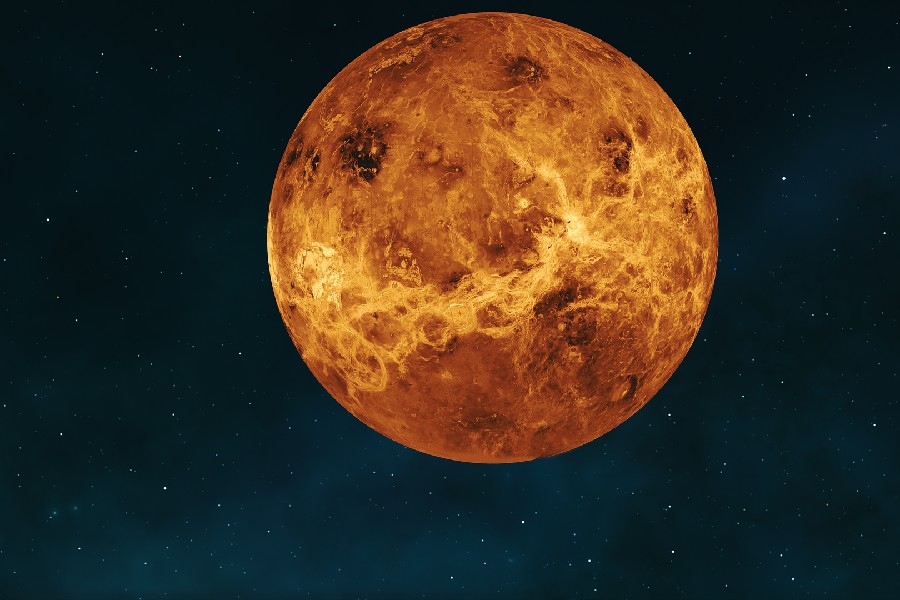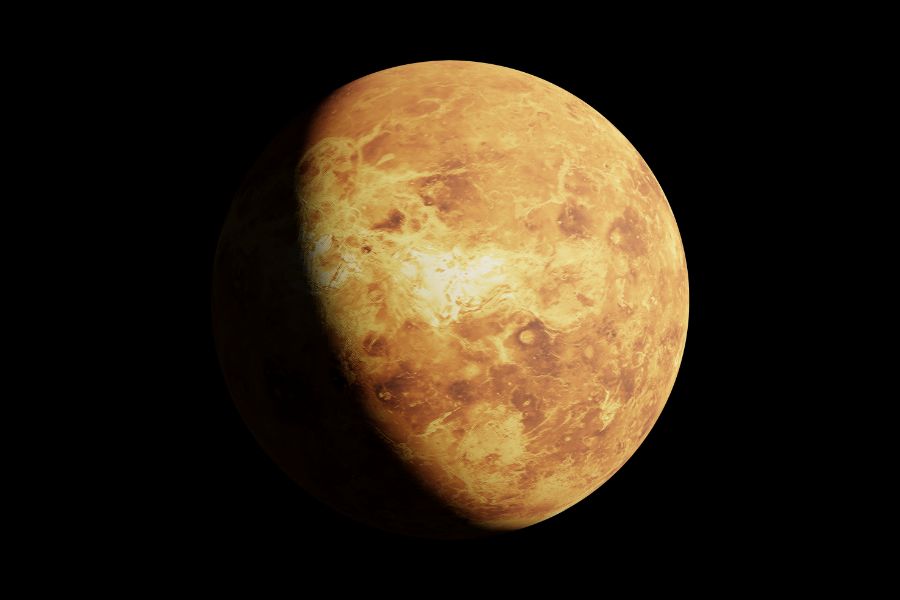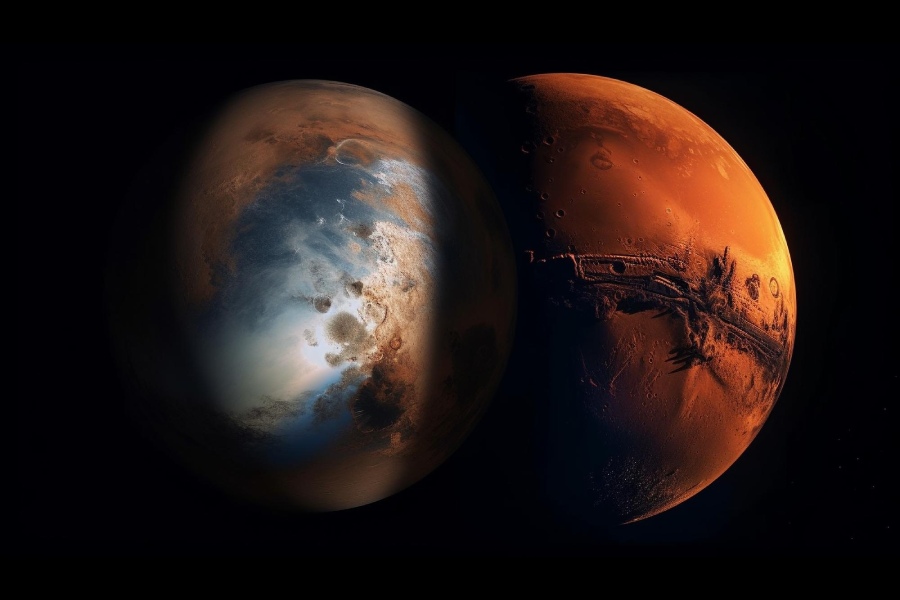While Earth enjoys temperate climes, Venus cradles an environment of extremes. Think of a place where the air’s so heavy it could crush you, and temperatures are hot enough to melt metal. That’s Venus – where even spacecraft don’t dare tread.
In this article, we’re diving into the wild Venus climate, uncovering its unique climate quirks. From a relentless greenhouse effect to winds racing around the planet at a pace surpassing its rotation, Venus is a place of wonder and danger.
But why should we care about this blistering world? The answer is in the secrets Venus holds about our climate system and the urgent issue of climate change. By peeking into this cosmic furnace, we gain precious insights into our planet’s climate.

What Is the Venus Climate Like?
Venus has an extreme and inhospitable climate characterized by scorching temperatures and a thick carbon dioxide-rich atmosphere that creates a runaway greenhouse effect. It also exhibits crushing atmospheric pressure, hurricane-like winds, and acidic rain.
Its climate is vastly different from Earth’s, making it one of the harshest environments in our solar system. Now, let’s go deeper into understanding the climate of the hottest planet in our solar system, Venus.
Understanding Venus’s Climate
Venus’s climate is primarily shaped by its atmosphere, which differs significantly from Earth’s. While Earth’s atmosphere is predominantly composed of nitrogen and oxygen, Venus boasts a vastly different composition.
The thick atmosphere of Venus consists mainly of carbon dioxide (over 96%), with trace amounts of other gases like sulfur dioxide and water vapor. This high concentration of carbon dioxide is crucial in creating the extreme conditions that characterize the planet’s climate.
The greenhouse effect on Venus
One of the most defining features of Venus’s climate is its extreme greenhouse effect. This effect occurs when the planet’s thick carbon dioxide-rich atmosphere traps heat from the Sun, preventing it from escaping back into space.
As a result, temperatures on Venus soar to extraordinary levels, making it the hottest planet in our solar system. We will explore the mechanics of this greenhouse effect in detail and how it leads to the blistering temperatures experienced on Venus.
Extreme surface conditions
Venus’s climate isn’t just hot; it’s characterized by a combination of extreme factors that make the planet a hostile environment. Surface temperatures on Venus can reach a scorching 900 degrees Fahrenheit (475 degrees Celsius), hot enough to melt lead.
Additionally, the atmospheric pressure at the planet’s surface is about 92 times greater than that of Earth, equivalent to the pressure found 3,000 feet (900 meters) underwater on Earth.
This crushing atmospheric pressure, coupled with hurricane-like winds and acidic rain, creates surface conditions that are not only inhospitable but also intriguing from a scientific perspective.
Atmospheric Dynamics of Planet Venus
Venus, our celestial neighbor, boasts a complex and dynamic atmosphere, setting it apart as a unique entity in our solar system.
Here, we delve into the intricate workings of Venus’s atmosphere, its fascinating super-rotational phenomenon, elaborate circulation patterns, and the high-speed winds.
Super-rotational atmosphere
One of the most intriguing aspects of Venus’s atmosphere is its remarkable super-rotational nature. While most planets, including Earth, rotate in a prograde direction, moving from east to west in alignment with their orbit around the Sun, Venus takes a divergent path. It exhibits a retrograde rotation from west to east, contrary to its orbital motion.
This peculiar rotation pattern is more than just an astronomical oddity; it significantly impacts the planet’s atmospheric dynamics. As a result of this retrograde rotation, a day on Venus is surprisingly longer than its entire year, clocking in at approximately 243 Earth days.
This striking contrast between its day and year, combined with a thick cloud cover, gives rise to the captivating super-rotation phenomenon within Venus’s upper atmosphere.
Atmospheric circulation patterns
Venus’s atmosphere is a realm of intricate circulation patterns intertwined by the planet’s super-rotational nature. These circulation patterns are marked by a stark disparity in the speeds at which the planet’s surface and upper atmosphere move.
This contradiction creates a complex interplay of winds and currents that govern the planet’s climatic behavior. Understanding these circulation patterns is of paramount importance when deciphering the enigmatic climate of Venus.
These intricate dynamics contribute to the distribution of extreme conditions. For example, the scorching surface temperatures that can melt lead and the crushing atmospheric pressure experienced at the planet’s surface.
High-speed winds and their impact
Among the defining features of Venus are its hurricane-like winds, known as super-rotational winds. These fierce winds whip around the planet at astonishing velocities, reaching up to 200 miles per hour (322 kilometers per hour) in the upper reaches of its atmosphere.
These high-speed winds are not merely meteorological curiosities but integral to Venus’s climate system. They are vital in redistributing heat throughout the planet, aiding in maintaining its searing temperatures.
Additionally, these powerful winds profoundly influence the planet’s climate and weather patterns. They sculpt the atmospheric landscape in ways that continue to intrigue scientists and researchers.

Cloud Cover and Acidic Atmosphere
Venus is enveloped in a perpetual, thick, and unyielding layer of clouds. These clouds are predominantly composed of sulfuric acid droplets, forming a dense, acidic shroud that effectively obscures the planet’s surface from view.
This cloud cover, more than just an atmospheric feature, plays a multifaceted role in Venus’s extreme climate. First, it acts as a formidable sunlight reflector, sending significant incoming solar radiation back into space. This reflection contributes to the maintenance of the planet’s scorching surface temperatures.
Furthermore, these clouds are involved in a peculiar phenomenon observed on Venus’s night side – the ashen light. This phenomenon results from sunlight scattering off the upper cloud layers, creating an eerie glow that has puzzled astronomers and planetary scientists for generations.
In sum, the atmospheric dynamics of Venus, with its super-rotational nature, intricate circulation patterns, high-speed winds, and acidic cloud cover, form a tapestry of complexity. It is scientifically captivating and integral to understanding the planet’s extreme climate.
Did Venus Experience Climate Change?
Studying Venus’s climate history is essential to understanding the planet’s current extreme conditions. From telescopic observations and data collected by spacecraft, historical climate studies have revealed clues about Venus’s changing climate over geological timescales.
These studies indicate that Venus may have once had more moderate conditions, possibly even liquid water on its surface, before transitioning to the inferno we observe today.
Ongoing climate research
Scientific investigations into Venus’s climate are ongoing, with the help of advanced space missions and computer modeling. Researchers are working to unravel the mysteries of Venus’s climate change, including the factors that led to its runaway greenhouse effect.
Such missions provide valuable data to refine our understanding of Venus’s climate system and its potential implications for Earth’s climate research.
How is Venus affected by climate change?
Venus itself is experiencing the effects of climate change, although in a drastically different manner compared to Earth.
As researchers uncover more about the planet’s climate history, they can identify patterns of change and potential feedback mechanisms that have led to today’s extreme conditions. Studying these effects contributes to our broader understanding of climate dynamics in the solar system.
What caused Venus’ climate change?
The causes of Venus’s climate change are multifaceted and interconnected. The planet’s runaway greenhouse effect, driven by its thick carbon dioxide-rich atmosphere, is a primary factor.
Understanding how this effect unfolded, and its potential triggers is a critical area of study. Additionally, factors such as volcanic activity, tectonic processes, and the loss of a magnetic field have all played roles in Venus’s changing climate.
Comparisons with Earth’s Climate
Comparing Venus’s climate to Earth’s provides invaluable insights into planetary climate systems. While Earth enjoys a temperate climate conducive to life, Venus’s extreme conditions serve as a stark contrast.
These comparisons help scientists better understand the factors that regulate climate on both planets, from greenhouse gas concentrations to atmospheric circulation patterns.
Greenhouse effect and climate stability
One of the most significant differences between the two planets is the role of the greenhouse effect. Both Venus and Earth have atmospheres rich in greenhouse gases, but the outcomes are dramatically different.
On Earth, the greenhouse effect is a stabilizing force that maintains temperatures within a habitable range. However, the runaway greenhouse effect on Venus has resulted in a scorching environment.
Atmospheric circulation patterns
Comparing atmospheric circulation patterns between Venus and Earth reveals intriguing distinctions. While Earth’s atmosphere is characterized by complex patterns that distribute heat across the planet, Venus’s super-rotational atmosphere whips around the planet at high speeds, creating a chaotic and inhospitable environment.
Implications for Earth’s climate research
Studying Venus’s extreme climate provides essential lessons for Earth’s climate research. It emphasizes the significance of maintaining a delicate balance in greenhouse gas concentrations and the consequences of disrupting this balance.
We should learn to mitigate climate change on Earth, highlighting the importance of understanding planetary climate systems to preserve habitable conditions.

Are There Any Future Missions to Venus?
As we continue to unravel the mysteries of Venus, the next frontier lies in the future missions. Scientists and space agencies worldwide are gearing up for a new era of exploration, with several exciting missions planned to delve deeper into the enigmatic world of our scorching planetary neighbor.
1. NASA’s VERITAS
NASA’s VERITAS mission is set to revolutionize our understanding of Venus’s geology and history. This spacecraft, equipped with state-of-the-art instruments, will map the planet’s surface in unprecedented detail.
By studying the planet’s topography and surface composition, VERITAS aims to shed light on Venus’s geological evolution, including the presence of volcanoes and tectonic activities. Additionally, it will employ radar to penetrate the thick cloud cover and uncover the planet’s hidden terrain.
2. ESA’s EnVision
The European Space Agency (ESA) is planning to launch the EnVision mission, focusing on Venus’s atmosphere and surface. This mission aims to understand the planet’s complex climate dynamics, studying its atmosphere’s composition, cloud patterns, and trace gases.
EnVision will also investigate Venus’s volcanic history and tectonic activity, shedding light on the planet’s geological past.
3. ISRO’s Shukrayaan-1
The Indian Space Research Organisation (ISRO) is preparing for its maiden voyage to Venus with the Shukrayaan-1 mission. This ambitious endeavor aims to explore Venus’s surface, atmosphere, and plasma environment.
Shukrayaan-1 will carry instruments to study the planet’s surface mineralogy, geology, and the interaction between its atmosphere and solar winds. This mission promises to provide valuable insights into Venus’s evolution and its connection with the Sun.
4. Private ventures and international collaboration
Beyond government space agencies, private companies, and international collaborations are also eyeing Venus exploration. With the growing interest in the potential habitability of Venus’s clouds, there may be missions to study these regions more closely. Such missions could explore the possibility of microbial life in Venus’s atmosphere or harness its resources for future space endeavors.
Frequently Asked Questions
Is Venus too hot to live on?
Venus is far too hot to support humans or most terrestrial life forms. Surface temperatures on Venus can soar up to 900 degrees Fahrenheit (475 degrees Celsius), which is hotter than the surface of Mercury, the closest planet to the Sun.
Additionally, the planet’s crushing atmospheric pressure and toxic atmosphere make it incredibly inhospitable.
Is there water or ice on Venus?
Venus is extremely dry, with almost no water vapor in its atmosphere. The planet’s scorching temperatures would cause any water to evaporate quickly. While some research has suggested the possibility of water ice in the polar regions, it remains a subject of study and debate.
Why is Venus’s climate often called a “runaway greenhouse effect,” and how does it work?
Venus’s climate is often described as a “runaway greenhouse effect” because of the way its atmosphere traps heat. Venus’s thick carbon dioxide-rich atmosphere allows sunlight to enter but prevents much of the heat from escaping back into space.
As a result, temperatures continue to rise, causing more water vapor to evaporate. Water vapor is a potent greenhouse gas, further intensifying the heat-trapping effect. This cycle continues, creating a scorching, uninhabitable environment.
Are there any proposed solutions or technologies to mitigate Venus’s extreme greenhouse effect?
Mitigating Venus’s extreme greenhouse effect would be an enormous challenge and currently remains a topic of scientific study and exploration rather than a realistic engineering project.
Some speculative proposals involve launching massive shades into space to block sunlight or developing technologies to remove carbon dioxide from the atmosphere.
However, these concepts are theoretical and would face immense technical and logistical challenges. Venus serves as a cautionary example of the potential consequences of unchecked greenhouse gas emissions, emphasizing the importance of addressing climate change on Earth.
Conclusion
Venus climate holds vital lessons for understanding planetary climate. Its searing conditions, driven by a runaway greenhouse effect, emphasize the delicate balance of Earth’s climate. Comparing Venus and Earth reveals the critical role of greenhouse stability in maintaining our planet’s habitability.
The study of Venus’s tumultuous atmosphere and extreme climate patterns provides invaluable insights into climate regulation on both planets. These lessons highlight the urgency of addressing climate change on Earth and preserving our world’s fragile equilibrium.
While Venus may be an inhospitable neighbor, it is a stark reminder of the consequences of unchecked greenhouse gas emissions and the importance of safeguarding our planet’s climate for future generations.

